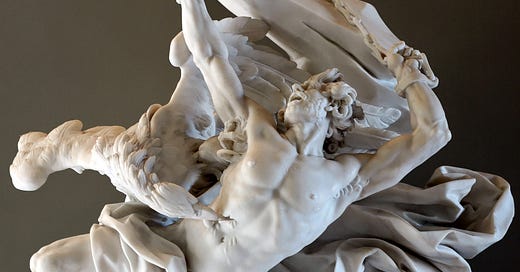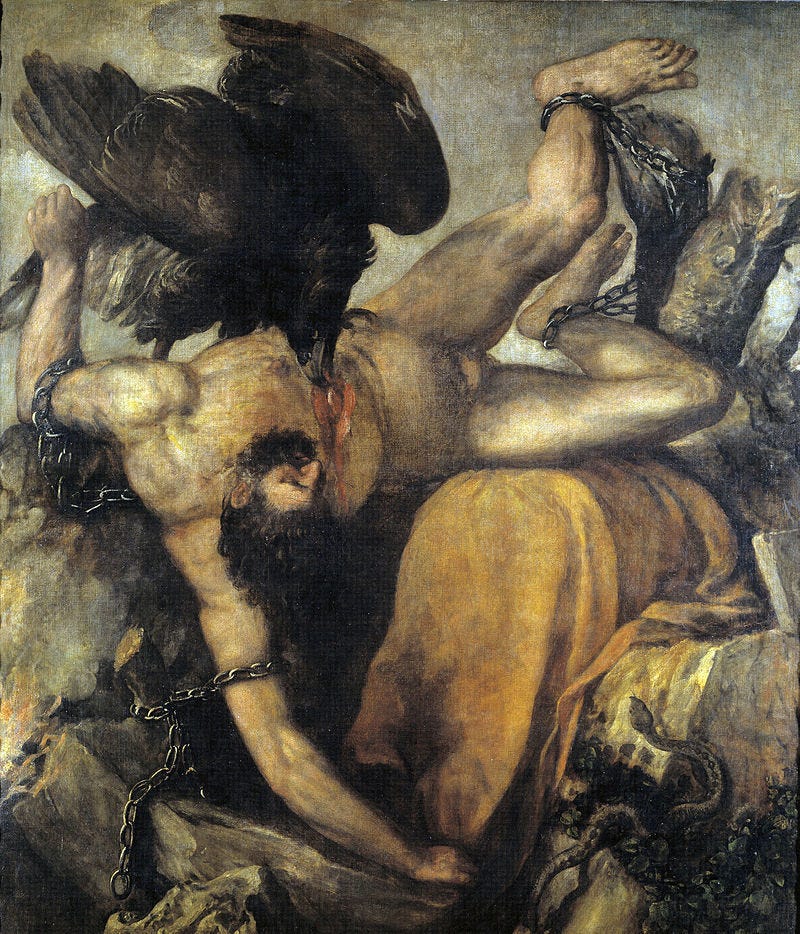OK, bonus round: In Greek mythology the titan Prometheus is condemned by the supreme Olympian god Zeus for having stolen fire and given it as well as reason to humans. Prometheus is chained to a mountain and every day an eagle pecks out and eats part of which of his organs?
No, not his spleen. Not the kidneys either. Not even some NSFW answer you might think given the ancient gods’ tendency to go around in the buff.
Prometheus is sentenced to be tortured for eternity by having his liver eaten every day and having it grow back overnight. Ewww, right?
But also rather interesting when you learn that the liver is the body’s only visceral organ that can regenerate. Take out about half of it, and the liver has mechanisms that allow it to grow back to full size.
Having your liver chewed on by an eagle certainly sounds pretty dreadful. And in “Prometheus Bound,” written by the Greek playwright Aeschylus around 430 B.C.E., the god Hermes spells out Prometheus’ torment rather gleefully:
The hound of Zeus, the tawny eagle
Shall violently fall upon thy flesh
And rend it as ‘twere rags; and every day
And all day long shall thine unbidden guest
Sit at thy table, feasting on thy liver
Till he hath gnawn it black.
Again, ewww! But did the Greeks know then about the liver’s regenerative capability? They believed that the liver, which they called the “hepar,” was the seat of the soul and source of emotions. They also engaged in extispicy, which involved using animal entrails, especially the liver, in divination rituals.
The Greeks must have understood about liver regeneration because “hepar” comes from their verb hēpaomai, which means to mend or repair. Today’s medical specialists study hepatic diseases, and numerous scientific papers on hepatology bring in the myth of Prometheus and another Greek legend.
For Prometheus isn’t the only Greek story that involves avian torture of a liver. There’s also the tale of Tityus, son of Zeus and a gigantic woman named Elara.
Tityus tries to rape Leto, mother of the sun god Apollo, and Zeus (again!) has the giant Tityus bound in Hades and tortured for eternity by having his liver eaten every noon by two vultures. And as with Prometheus’, Tityus’ liver grows back.
The myths of Prometheus and Tityus (but especially Prometheus!) have been depicted by many painters, sculptors and writers over the centuries. If you want a rather comprehensive understanding of this connection between art and science, check out “Prometheus and the Liver through Art and Medicine,” published by Amsterdam University Press.
In an article titled “Tityus: A forgotten myth of liver regeneration,” published in the Journal of Hepatology in 2010, the writers note:
In general, the Promethean myth is mostly employed in liver scientific meetings where transplant surgeons often show the grand painting of Peter Paul Rubens (1618) as the unofficial emblem of their profession. Rubens’ majestic work portrays a giant eagle piercing Prometheus’ right hypochondrium and holding a portion of his liver in its beak. This painting is probably the most common depiction of the punishment of Prometheus used by lecturers on hepatic regeneration.
So medical specialists and scientific researchers are using a 400-year-old painting of a 2,500-year-old myth when discussing the latest advances in healing hepatic trauma?
You have to admit – that would liven up their PowerPoint presentations.






